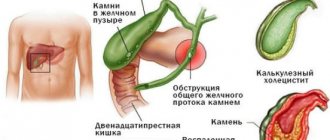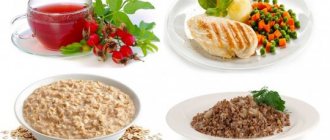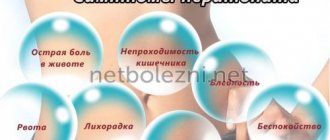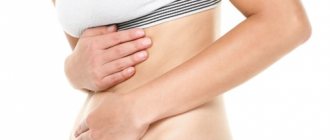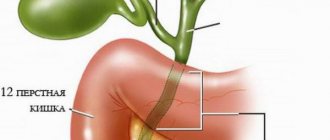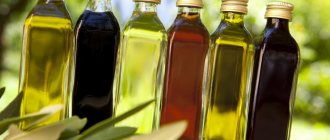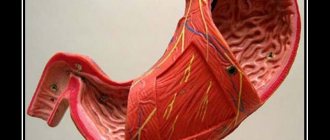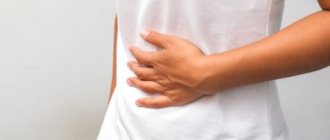Characteristics of the disease
Inflammation of the gall bladder is one of the complications of cholelithiasis, characterized by impaired bile outflow. The main function of the organ is to collect, store and supply bile to the intestines. Violation of the normal functioning of the organ negatively affects the general condition of the body.
Signs of the disease appear:
- dryness or bitterness in the mouth, having a iron taste;
- skin inflammatory reactions, including pigmentation;
- gastrointestinal dysfunctions (diarrhea, constipation);
- subcostal, pancreatic, lumbar pain.
Organ dysfunction, or cholecystitis, as inflammation of the gallbladder is scientifically called, is expressed in impaired motility of the common bile duct. Cholecystitis is distinguished:
- calculous in acute and chronic forms;
- non-calculous in acute and chronic forms.
The calculous form is a direct consequence of cholelithiasis. A terrible symptom of the onset of complications with this type of cholecystitis is hepatic colic.
The calculous form is characterized by the formation of stones in the body of the bladder, clogging the bile ducts. Sand and stones with a fraction of less than 3 mm are able to independently leave the cystic body, while larger pebbles get stuck in the bile duct, tightly clogging it. The patient begins to develop hepatic colic, obstructive jaundice develops - the skin and mucous membranes turn yellow due to the entry of bile pigments into the blood.
The acute form of inflammation of the gallbladder, in turn, classifies cholecystitis according to morphological characteristics:
- catarrhal, manifests itself as pain of significant intensity in the right hypochondrium, in the iliac region with a return to the lower back, right leg;
- phlegmonous, the painful syndrome is more pronounced than that of catarrhal syndrome, which increases with the slightest movement;
- The gangrenous type is characterized by an intense course, severe pain, and necrosis of the mucous membrane.
Chronic cholecystitis develops independently or as a result of an acute course.
Signs of chronic cholecystitis:
- nausea;
- dull pain on the right under the ribs;
- discomfort after eating.
Chronic cholecystitis can be catarrhal and purulent.
The catarrhal variety is characterized by thickening of the bladder walls and constant pain. Despite this, catarrhal inflammation is considered one of the milder forms of the disease.
Purulent empyema is characterized by the accumulation of pus in the organ cavity and occurs when infected with pathogenic microflora. Accompanied by fever, nausea, and girdle pain. Dangerous by the development of peritonitis and sepsis.
How to treat cholecystitis?
Since the cause of cholecystitis is an infection, if there are signs of its exacerbation (pain, fever, changes in blood tests), antibiotics are prescribed, but it is better to entrust this to a doctor, who ideally has the results of bile culture on hand. But at home you can and should be treated with the following means:
- Follow a diet. During an exacerbation, you can generally fast for a day or two, but at the same time drink weak tea, juices or fruit drinks diluted with water 1:1, or still mineral water. Then add puree soups and porridges, then low-fat cottage cheese, boiled meat and steamed fish, and after 5-7 days you can switch to a gentle, but completely physiological diet, excluding fried foods, fatty foods, such as goose or cream cakes, smoked and spicy foods. seasonings (for example, horseradish or mustard). It is better to eat often, every 3 hours, but little by little.
- For pain, take antispasmodics. This is a traditional no-spa (2 tablets three times a day, but no more, read the side effects in the annotation and make sure that this is a serious drug and an overdose is unacceptable), papaverine (can be taken in suppositories - many note that the effect is even better than from tablets), duspatalin 1 tablet 2 times, 20 minutes before meals.
- The choice of choleretic drugs depends on the motility of the biliary tract.
If stagnation (hypotension) predominates, then you need
- cholekinetics: flamin, berberine, sorbitol, xylitol and magnesium sulfate (magnesium).
- Tubages are also a great help in this case. Traditional healers often recommend this particular method, calling it “liver cleansing.” In the morning on an empty stomach you need to drink about a glass of warm mineral water without gas, in which you can dissolve a tablespoon of sorbitol, xylitol or magnesium. Then you need to lie on your right side, on a warm heating pad and remain in this position for one and a half to two hours. Tubage can be performed once every 3 days, the course is usually 10 procedures. But, if cholelithiasis cannot be ruled out, this procedure is quite capable of causing blockage of the bile duct with a stone, and this is an indication for immediate surgery. Stones with a diameter of about a centimeter are especially dangerous - smaller ones can come out, but larger ones will not pass into the ducts.
- Mineral waters with high mineralization (such as “Arzni” or “Essentuki 17”) are preferable - they are drunk half an hour to an hour before meals, at room temperature.
- Choleretic herbs - immortelle, corn silk, St. John's wort can be brewed and drunk for a long time, periodically (in the autumn-winter period) adding adaptogens to them - Rhodiola, Schisandra, Eleutherococcus, ginseng, which can also increase the tone of the gallbladder (and vitality in in general). Herbs are quite bitter, but a spoonful of honey will make the drink both tastier and healthier.
If spastic dyskinesia predominates, it is better to use
- choleretics: containing bile (allochol, lyobil), plant origin (cholagol, olimethine), synthetic (nicodine, oxaphenamide).
- Mineral waters (such as “Slavyanovskaya”, “Smirnovskaya”, “Narzan”) are classified as “hydrocholeretics”. It is better to drink warm water 5-6 times a day before meals.
- Herbs such as mint, chamomile, as well as motherwort and valerian help relieve spasms and normalize the flow of bile.
- You can arrange pine baths - not hot and no more than 15 minutes, in 10-day courses.
In general, we can say that treating cholecystitis at home is even a pleasant experience - if you think about herbal tea, delicious mineral water or relaxing baths.
Reasons for the development of pathology
Why does the gallbladder become inflamed? Several factors lead to the occurrence of the inflammatory process, the leading of which are:
- bile stagnation;
- penetration of pathogenic microflora.
The reasons for stagnation of bile and its thickening are:
- biliary dyskinesia;
- previously formed stones;
- pathologies of the sphincter apparatus;
- cystic anomalies, deformities (congenital or acquired);
- physical inactivity;
- predominance of fatty, fried, spicy foods in the diet;
- hormonal disorders (mainly in women, including during pregnancy).
Stagnation of bile is characterized by its loss of normal physicochemical properties, such as disruption of the colloidal structure and a change in the alkaline balance towards increased acidity.
As a result, its bactericidal properties are reduced, which contributes to the development of pathogenic processes. Vascular disorders, such as atherosclerosis of the abdominal vessels, capillary toxicosis, hypertensive crisis, can negatively affect the walls of the organ, causing inflammatory changes.
Causes of inflammation of the gallbladder of an infectious-bacterial nature:
- bacterial infections (causative agents - Escherichia coli, enterococci, staphylococci, proteus);
- parasitic infestations (giardiasis, ascariasis; amoebiasis).
The bacterial route of infection can be:
- ascending;
- hematogenous.
With an ascending route of infection, microorganisms enter the gallbladder from the duodenum; hematogenous infections occur from other foci of chronic infection in the body, for example:
- diseases of the teeth and oral cavity (periodontal disease; caries; gumboil);
- purulent processes (sinusitis, otitis media, etc.).
Manifestation of acute cholecystitis
Treatment
Cholecystitis is treated comprehensively. First aid for cholecystitis can only be provided if the patient knows exactly his diagnosis and has a prescription from the attending physician. Self-prescribing medications is not recommended.
If clinical and laboratory signs of inflammation and positive results of bacteriological culture of the contents of the gallbladder are detected, antibiotic therapy is prescribed. The doctor selects drugs, taking into account their ability to concentrate in bile in each specific case.
The following will help eliminate symptoms and normalize the functioning of the biliary tract:
- analgesics - Baralgin, Analgin;
- anticholinergics - Platiphylline;
- antispasmodics - No-shpa, Papaverine, Mebeverine;
- anticholinergic drugs - Riabal.
In case of hypotension of the gallbladder with the absence of stones, choleretic drugs are prescribed: Allahol, Cholenzym or herbal medicine.
Traditional medicine is widely used in the treatment of cholecystitis. Medicinal plants such as corn silk, immortelle, St. John's wort, tansy increase the secretion of bile, reduce its viscous structure, and have a general anti-inflammatory effect on the affected organ. Herbal medicine is recommended during remission of the disease for 1 month.
The presence of microlites in bile, the presence of cholestatic syndrome and hypotension of the gallbladder require the prescription of bile acid preparations for up to 3 months, for example, ursodeoxycholic acid.
Normalization of the biliary function of the liver with the help of hepatoprotector drugs that have a choleretic effect. For example, Hofitol is a herbal preparation consisting of an aqueous extract of artichoke leaves.
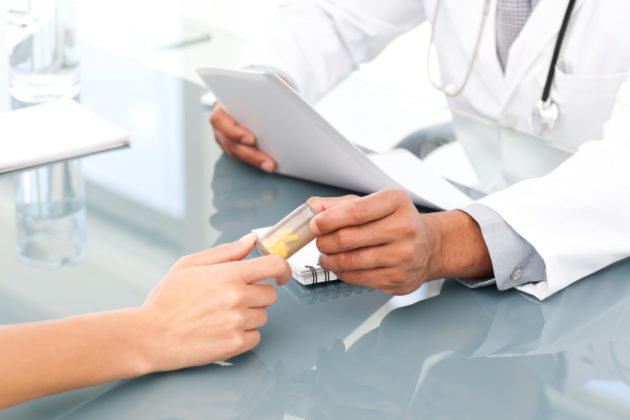
Gepabene, a combined herbal preparation consisting of milk thistle extract and fumaria officinalis, has also proven itself. The course of treatment with hepatoprotectors is long, at least 1 month.
For vegetative-vascular dystonia, the doctor may prescribe sedatives (motherwort, valerian) and anxiolytic drugs (Adaptol).
The nature of pain in the disease
Attacks of a fully developed disease are not yet acute and painful, but background dull pain may occur:
- after waking up (associated with the accumulation of bile during the night);
- when moving (for example, walking - associated with mechanical pressure on the gallbladder);
- after eating (associated with a reflex contraction of the bile-storage organ).
This is how the gallbladder manifests itself, the inflammation of which is in the initial stage of development of cholecystitis.
The disease, which has entered the clinical stage, is characterized by the following pain manifestations:
- girdle pain in the lumbar region, hypochondrium, radiating to the sternum and right side of the neck, accompanied by nausea;
- abdominal pain accompanied by diarrhea;
- stifling pain during inflammation of the gallbladder covers the entire hypochondrium, occurs when stones pass and when the bile duct is blocked.
Features and causes of biliary tract pathologies in children
Children are often diagnosed with an acute non-calculous form of cholecystitis, characterized by general intoxication of the body.
Contrary to popular belief, inflammation of the gallbladder can have causes completely unrelated to food - chronic pathologies are caused by upper respiratory tract infections and ENT diseases, such as tonsillitis, tonsillitis, sinusitis, etc.
Secondary inflammation of the gallbladder in children can be triggered by previous gastritis, appendicitis, scarlet fever, influenza, and intestinal disorders of various etiologies (dysentery).
The development of pathologies of the biliary tract in a child is often provoked by infection with protozoan parasites: roundworms, hepatic giardia, trematodes Opisthorchis felineus, Fasciola hepatica, etc.
A sedentary lifestyle, an unbalanced diet, dry food, which all children love so much, fast food and sweet sodas increase the risk of developing gallstone disease.
